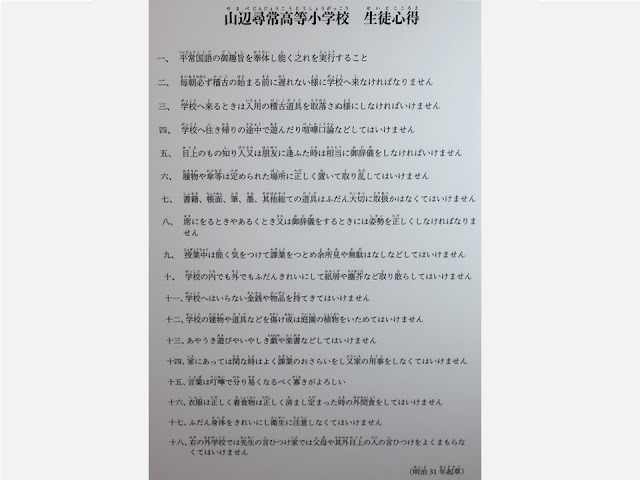The elementary school building was
constructed in 1885 at the outskirt of Matsumoto City, Nagano Prefecture. Kaichi school, which is a western style building and is designated
as the National Treasure, was very costly. Therefore, Yamabe school was
basically designed as a Japanese style one.
The building was used as a school until
1928, then, was used as a village office and a community center; it is used
as a museum of the school history and folklore now. It says, “we let you
know how passionate the villagers were into the education”. I also introduce a hot
spring facility.
1885年(明治18年)に松本市郊外に建てられた小学校です。開智学校がコスト高だったので、障子を使った和風の学校として建設されました。
長野県には、古い校舎がたくさん残っています。本校舎は、1928年まで校舎として利用された後、役場や公民館として利用され、今は民俗資料も展示する資料館になっています。「教育にかける村人の心意気を今に伝えます」と書かれていました。学校や教育を大切にする気風がありますね。近くにある浅間温泉・枇杷の湯とともに紹介します。
Hallway in the first floor. The classrooms are converted to exhibition rooms.
一階の廊下。教室が展示室になっています。
Yamabe district is at the foot of Utsukushigahara (beautiful field) which highest peak is Ohgatou.
山辺は、松本市の東側、美ヶ原(主峰:王が頭)の山麓です。
The speech scripts at the opening ceremony are exhibited. The student told, “We study hard and live properly, and repay this great obligation.”
開校式での東筑摩郡長の挨拶と、山辺尋常小学校・生徒総代の武井武一君の答辞。「勉強に励み、人たる道を全うして本日の洪恩に酬(むく)います」と述べています。先生の手が入っているとは思いますが、清々しいですね。
The student regulation describes the school lifestyle in details.
生徒心得は、儒教の世界ですね。
Textbooks of calligraphy (lower left) and local geography (upper right) are similar to those in the Edo period (1603~1868) when samurai ruled Japan.
信濃地理と習字の教科書。まだ、江戸時代の風を感じます。
It’s a mixed education. Pupils looks serious.
生徒達。いい顔をしています。共学ですね。
The organ made by YAMAHA was purchased in 1898. It’s an icon of the westernized education. It’s very rare, so the organ was introduced to villagers (upper right). It is written people were surprised so much.
1898年に購入したヤマハ製のオルガンは、西洋的な音楽教育の走りでした。オルガンを荷車に乗せて、村中を引き回して披露しました。人々が集まってきて、驚きの声を上げたそうです。明治に全てが変わりました。
There are old desks in the Japanese style hall. I touched the desk which was made in 1840. Those are used very carefully.
この広間もいいです。山辺小学校で使われていた「天保11年」と書かれた机に触れました。物が大切にされています。
Folklore exhibition、民俗展示
Stone statues are exhibited. Yamabe was a stone producing area.
旧教室には、道祖神などの石像も展示されています。山辺は、石材の産地でもあったそうです。
There are statues regarding sex; those are symbols of descendants’ prosperity.
ユニークな道祖神のパネル。宮原の実物は、柵の中にありました。
“Oyouka” rites are introduced in details, which are events in order to drive away bad fortune. For example, people bring a straw dragon or horse to the edge of their village and burn them. Those are impregnated with stimulus smell such as chili beforehand.
「お八日(ようか)」行事はとても詳しい展示です。唐辛子などの匂う物をいぶして、藁で作った龍や馬を集落の入口に持って行き、焼いたりします。辻切りだと思いますが、行事の内容が詳しく書かれています。
Bringing away a god of poverty or disease、貧乏神送りと風の神送り
(If you’d like to know the explanation in Japanese on the panel, contact me.)
Tug of war using the straw dragon、お八日の綱引き
A research report of Oyouka (2011) shows us how people enjoy it.
行事の詳細を記した「松本のコトヨウカ行事」調査報告書(松本市教育委員会、2011)。人々の楽しみが伝わってくる本です。
Reference: Ofune museum of Hotaka Shrine、穂高神社・御船会館
山辺の祭は、「お船祭り」と「御柱祭り」。「お船祭り」では、船の形の山車が、曳航されます。お隣の安曇野と同じく海洋民族のなごりです。
People stand up a pole, which more than 15m long, in shrine grounds. It’s “Onbashira festival”.
一方、「御柱祭り」では、諏訪地方のように、御柱が立てられます。神楽桟は巻上機です。
The photo above is a replica of a farmer’s room in the late 19th century. The thin wood chips beside the irori fireplace are used to light a fire. It’s an elaborate exhibit.
明治中頃の農家の一室が再現されています。囲炉裏の火をおこす、付け木も展示されていました。
Fishes are smoked above the irori fireplace.
炉の上では、魚をいぶしています。
Wooden farming equipment are exhibited. The photo shows making a straw mat using the wooden tool.
木製農機具もしっかり展示されています。菰編み台は写真付き。
Industries in Yamabe、山辺の産業
The bamboo crafts are called "Misuzu-zaiku", which have been specialty of Yamabe since the Edo period (1603~1868). Some were exported to U.S.
みすず細工:笹の一種のスズタケを編んだ籠や菰(こも)は、江戸時代からの名産品で、アメリカにも輸出されました。
An ice manufacture was also the local industry. Until mid-1960s, people made ice in artificial ponds, cut them and shipped them by horses. Tools are exhibited.
藍染めと製氷も地場産業でした。昭和30年代まで、人工池で作った氷を、切り出して、荷馬車に載せて出荷しました。藍や氷を作る道具が展示されています。
The onsen hot-spring industry has been important. Yamabe is mentioned as a hot spring resort in the national history book “Nihon Shoki” written in the 8th century.
In the Edo period, the daimyo lord of Matsumoto built a villa and stayed there twenty to forty days when he visited. It was a heavy load for residents in Yamabe, because they had to work or guard while his staying.
そして、温泉業!
日本書紀に既に、温泉地として出ていました。江戸時代には、山家(やまべ)茶屋という松本藩主の別荘が設けられ、20~40日間滞在されたそうです。でも、山辺地区の人々には、手伝いや警備で大きな負担になったと書かれています。
Layout of the lord’s villa、藩主の温泉保養用別荘
“Biwa-no-yu” (hot-spring facility)、枇杷の湯
It’s in Asama onsen hot-spring resort which is just ten minutes away by car from Former Yamabe School. The lord's favorite; there is a pine tree which was planted by the lord.
旧山辺学校校舎から車で10分の浅間温泉にある日帰り温泉施設です。こちらも、松本の殿様が好んだ湯です。お手植えの松などがあります。
The valuables such as the hanging scroll which depicts relaxing people in a bathtub are displayed.
くつろいだ掛け軸などお宝が展示されています。楽しそう。外国の方には、女性がいることで違和感があるでしょうか。
At the entrance of the bathroom, a guest book in the Edo period is exhibited. “Biwa-no-yu” has a long history.
内湯の入り口前には、江戸時代の宿帳などが展示されています。
There is an open-air bath in the annex.
別棟にも露天風呂があります。
I could take a photo! Because there was nobody.
どなたもいらっしゃらなかったので、珍しく湯槽の写真を撮れました。
History of the hot-spring resort、浅間温泉の歴史
Matsumoto city history book has a chapter of “Recreation and Hot-spring”.
In the early 17th century, there were bathrooms for the lord (11sqm), vassals (13sqm) and people (5sqm).
In around 1664, residents started to dig for a hot-spring and to have a bathroom.
In 1692, around ten wealthy farmers had their own bathroom which area was 27sqm.
In 1718, there were more than three public bathhouses (13sqm). The admission fee is FREE. In 1861, the number of the public ones increased to nine.
In the early 19th century, Asama hot-spring resort became famous. Some farmers run inns in an agricultural off-season. Travelers such as Pilgrims to Zenkouji (temple) came. Local farmers also came to acquaintance’s residence for a hot-spring cure in an agricultural off-season. Town people of Matsumoto also came.
Japanese like onsen so much.
Brochure of Asama onsen、浅間温泉のパンフレット
「松本市史第二巻歴史編Ⅱ(近世)」に、「保養と温泉」という項があります。
松本藩が置かれた頃の浴室は、浅間温泉は、殿様6坪、家臣7坪、一般人の共同浴場(入込の湯)は3坪だったそうです。
1664年頃から、源泉付近の人々が自分の屋敷で源泉を掘り、内湯を設けるようになりました。
1692年には、10人が15坪の内湯持ちになり、内湯は村役人層に広がっています。
1718年になると、7坪の共同浴場などが3か所以上あり、無料で入浴できました。
1861年には、共同浴場は9か所になりました。
文化文政の頃からは、浅間の湯が方々へ宣伝され、農閑期を利用して宿を営む人も出てきました。善光寺への旅人などが湯治しました。近在の農民も、懇意な内湯を持つ家へ農閑期を利用して泊まりに来ました。松本の町人も来ました。
我々と同じだ!
Visited in May, 2021
Official website of “Former Yamabe School、旧山辺学校校舎”: https://matsu-haku.com/yamabe/ (in
Japanese)
Official website of “Biwa-no-yu”:
http://www.biwanoyu.com/ (mostly in
Japanse)
accessed in March, 2022
Previous post (museum in the same city): Museum of mountains and nature、山と自然の博物館
Next post: What is the fun of Japanese more than hundred years ago? 昔の人々の楽しみとは?(vol.1/r.2)


































Comments
Post a Comment